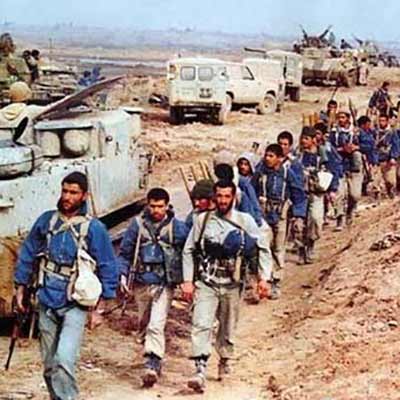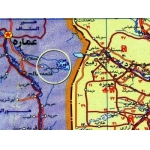Operation Quds-1
Mohammadali Abbasi Aghdam
222 بازدید
Operation Quds-1 was the first in a the series of limited operations that started on June 14, 1985 (coinciding with the International Quds Day). They were conducted under the command of the Islamic Revolutionary Guard Corps in the Hur al-Huwayzah area, north of the operational areas of Khyber and Badr. It ended on June 17, 1985.
The dimensions and characteristics of Operation Badr forced Iraq to react in a different manner; so, at the same time as this operation, it started air raids on Tehran. Confronting the Iraqi army in new dimensions required the active presence of the people and, in increasing their spirit of resistance, it required the necessary response. According to the opinion of Imam Khomeini, who said that, "war will be fought until sedition is removed from the world", his representative -Ayatollah Hashemi Rafsanjani - to the Supreme Council of Defense suggested in the Tehran Friday Prayers that those who supported the continued confrontation and war with Iraq should come out on Quds Day. This was done to make clear the people's opinion about the continuation of the war. Despite the Iraqi regime's repeated threats to bomb the people, the Quds Day march was held. At the same time, the fighters of the IRGC carried out Operation Quds-1 in the Hur al-Huwayzah area.[1]
The main goal of Operation Badr was to cut off the strategic Basra - al-Amara Road, which, due to the failure of this operation, the capture of this road and presence in Hur al-Hamar were still considered necessary by the commanders. However, it was not possible to implement other operations to achieve the aforementioned goals in the short term. For this reason, more presence in Hur and getting closer to the Basra - al-Amara Road were on the agenda. In this area of Hur, which stretches from the north of al-Bayda to the Tigris River, the best route to approach the Basra - al-Amara Road was chosen and it was deemed necessary to capture the checkpoints of Abu Zaker and Abu Laila.
Therefore, Operation Quds-1 aimed to capture the Abu Zaker and Abu Laila checkpoints and gain a suitable foothold for continuing operations in this axis. It also wanted to repair the defense line, bring it closer to the Tigris, and make it possible to fire at the Basra - al-Amara Road. This operation was designed and implemented by the 25th Karbala Division, and was handed over to the IRGC, Mazandaran Province.[2] After the notification of the mission, the intelligence forces of this division began to scout the area continuously and seriously. Four main targets were identified for the operation: Abu Zaker Checkpoint, Abu Laila Village, Barka Mokhtar, and Dezhbani. Identifications were made from the four axes of the Saf, Khaita, Ma'araj, and Azam Waterways. With the progress of the work and the control of the forces in the operation area, it was decided to identify two crossings for each target and to continue the identification work in eight crossings.[3]
The 25th Karbala Division formed a defense line in this area and stationed four battalions of troops to maintain the region and enable an active presence in it. They also raised the level of training and experience of its forces. Each battalion was obliged to approach Iraqi positions without conflict. Therefore, the forces advanced in front of the Iraqis with a completely effective attack, without any conflict or ambush, such that in some axes they got to within one or two kilometers from the Iraqi positions.[4]
The Iraqi army had occupied different positions and placed obstacles in this area. Barrels of explosives and circular barbed wire were examples of their obstacles. The Iraqis had built numerous trenches around the Abu Zaker Checkpoint and on the land around it. On the Mokhtar Pond, in addition to the trench, they had also set a mobile ambush, which covered each other in a zigzag pattern and was considered an effective factor in securing the Abu Zaker Checkpoint.[5]
On Friday, June 14, 1985, at the same time as people marched on International Quds Day across the country, the movement of troops towards the Iraqi army positions began. At 21:00, the commander of the 25th Karbala Division issued the order to start the operation by reciting the codename of the operation "Ya Muhammad Rasulullah, Ya Allah, Ya Allah, Allah Akbar". After that, the commanders of all axes started their operations.
The operation area was divided into two axes and two obstacles - "Tabar" and "Shat Ali" - were determined for it. According to the estimation of the area and the situation of the enemy, it was decided that five battalions would go into action. The route of the first axis were from Tabar to Kasr Aqueduct, Tarabeh Checkpoint, and Nahravan Aqueduct. The route of the second axis also reached from Shat Ali to the Saf Waterway and from there to the checkpoints of Abu Zaker and Abu Laila.
To support the operation, the air defense unit had planned for four 14.5 mm anti-aircraft guns to be deployed in the Nahrvan, Barke Mokhtar, Ma'araj, and Saf-Khita Waterways. The equipment unit of Lashkar had allocated four mini-Katyushas, 23 guns and three 106 mm cannons to be left floating in the waterways and ponds of Saf, Tarabeh and Mokhtar, to effectively support the troops.[6]
The first operation of this series of limited operations ended after three days of fighting. In this operation, an area of about 200 square kilometers was captured by Iranian fighters. An entire battalion of Iraq's 2nd Hattin Brigade was destroyed. In total, about 200 Iraqi forces were killed, 200 wounded and 100 captured. Also, fifteen boats, one PC7 aircraft and two helicopters of the Iraqi army were destroyed. Four pieces of anti-aircraft guns, six pieces of mortars and thirty pieces of the floating bridges were among the spoils of this operation. In Operation Quds-1, 40 Iranian soldiers were martyred, 30 injured and three were MIA.[7]
[1] The series of Operations Quds: mobilization on the fronts and preventing the enemy from calming down, Tehran: Islamic Revolutionary Guard Corps, Center for War Studies and Research, 2014, pp. 8 and 9.
[2] Nakhai, H., Mashhadi Farahani, H., Chronicle of the Iran-Iraq War, Book 37: Development of Relations with Asian Powers (June 14 to August 20, 2014), Tehran: Islamic Revolutionary Guard Corps, Center for War Studies and Research, 2014, p. 126; Quds operations series, p.90.
[3] Series of operations Quds, p. 21.
[4] Ibid, pp. 20 and 21.
[5] Ibid, p. 22.
[6] Ibid., pp. 23-26
[7] Ibid, pp. 18, 32 and 33.




